For me, there were only ever two places to go before my Interrail tour in the north: Narvik in Norway, simply because it is Narvik, the northernmost (known) city, so it has a certain prestige. And Kiruna, where I really wanted to visit the large ore mine. So how do you get there? What can you experience and how do you get on or back?
I have experienced all of this first-hand and would therefore like to report on it in this blog!
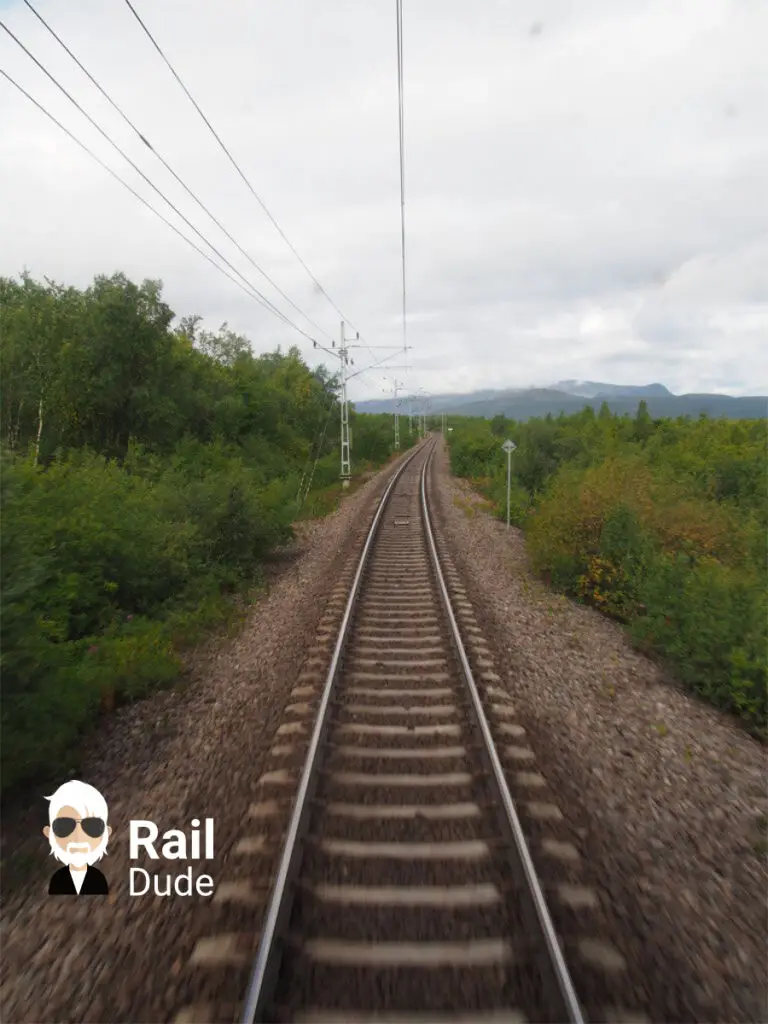
Travelling to Kiruna and Narvik
As an Interrailer, there is actually only one logical way of travelling: the NT (Nat-Tag = night train) from Stockholm. Departure there 18:11, arrival in Kiruna 09:12, (journey time 15 hours) arrival in Narvik 12:54, journey time just under 19 hours. From Norway, you can only get to Narvik from Bodö by bus, and to Narvik by train. Night train from Trondheim.
Timetable Kiruna-Narvik-Kiruna
I have summarised the rough timetable between these two cities in two tables here. Essentially, there are two trains a day, one of which is the night train to/from Stockholm, where you travel in a seat carriage. When I travelled in the summer of 2019, there was also an additional train with quite unusual departure times, which I have halfway remembered. Unfortunately, this train was no longer in the 2020 timetable, possibly due to the coronavirus. I have listed it anyway because I assume that it will be back in the coming seasons. It may only be published in the timetable at short notice. You can find all timetable data on the Deutsche Bahn website.
Status: 2025
| Train type | Night train from Stockholm NT94 | IC96 from Lulea | Amplifier train |
|---|---|---|---|
| Kiruna from | 09:31 am | 3:30 pm | approx. 22:30 |
| Abisko Tourist Station | 11:08 am | 4:49 pm | approx. 23:55 |
| Narvik to | 12:45 pm | 6:30 pm | 01:17 am |
| Journey time | 03:14 hours | 3 hours | approx. 3 hours |
| Traffic days | All year round | All year round | Summer (July/August) |
| Train type | Night train to Stockholm NT93 | IC95 to Lulea | Amplifier train |
|---|---|---|---|
| Narvik from | 3:11 pm | 10:25 a.m. | 6:30 pm |
| Abisko Tourist Station | 4:37 pm | 12:30 pm | approx. 20:30 |
| Kiruna to | 5:54 pm | 1:47 pm | approx. 21:30 |
| Journey time | 02:43 hours | 03:22 hours | approx. 3 hours |
| Traffic days | All year round | All year round | Summer (July/August) |
I have listed the three most important stops. Please check before travelling whether the train is actually running. Sometimes there are individual days when a train is cancelled as scheduled due to construction work or similar. All intermediate stops on the route can also be found on the DB website. Here on rail.cc you will find the stops of the night train.
Tickets
Tickets are available simply online. The ticket price is between around 15 and 50 euros, depending on the day of booking.
You can also buy Interrail passes for Europe or One-Country Sweden on our website buy. If you use these links to buy your ticket or overnight stay, we will receive a small commission from raildude to support free content such as this blog, so thank you for supporting us! The price of course remains the same.
Reservation
All trains can be used free of charge with Interrail. You only need a reservation for the night train, possibly also in the seating carriage, but only if you are travelling overnight to Stockholm. However, if you are travelling in the IC train section of the night train (this is detached in Boden to Lulea), then you do not need a reservation.
Travelling from Stockholm and Boden to Kiruna
I chose the night train Stockholm-Narvik for the journey, which only travelled as far as Kiruna that day due to construction work. I was awake from the ground, which is normally around six o'clock, but today it wasn't until nine o'clock, partly due to timetable changes. The station looks quite impressive, as it is reminiscent of old Viking buildings.
The subway is also beautifully designed. The train is shunted here, one part goes to Lulea, one part to Kiruna/Narvik. The part travelling to Narvik then picks up another part from Lulea, which is attached here. So you have almost half an hour here to stretch your legs.
In Boden, you can also take the trains from Norrtag to Lulea, Kiruna or (since 2020) to Haparanda.
When we set off again, we soon cross the Arctic Circle. The train stops right here and I can take a photo of the sign. However, the stop was probably for technical reasons and less for tourism.
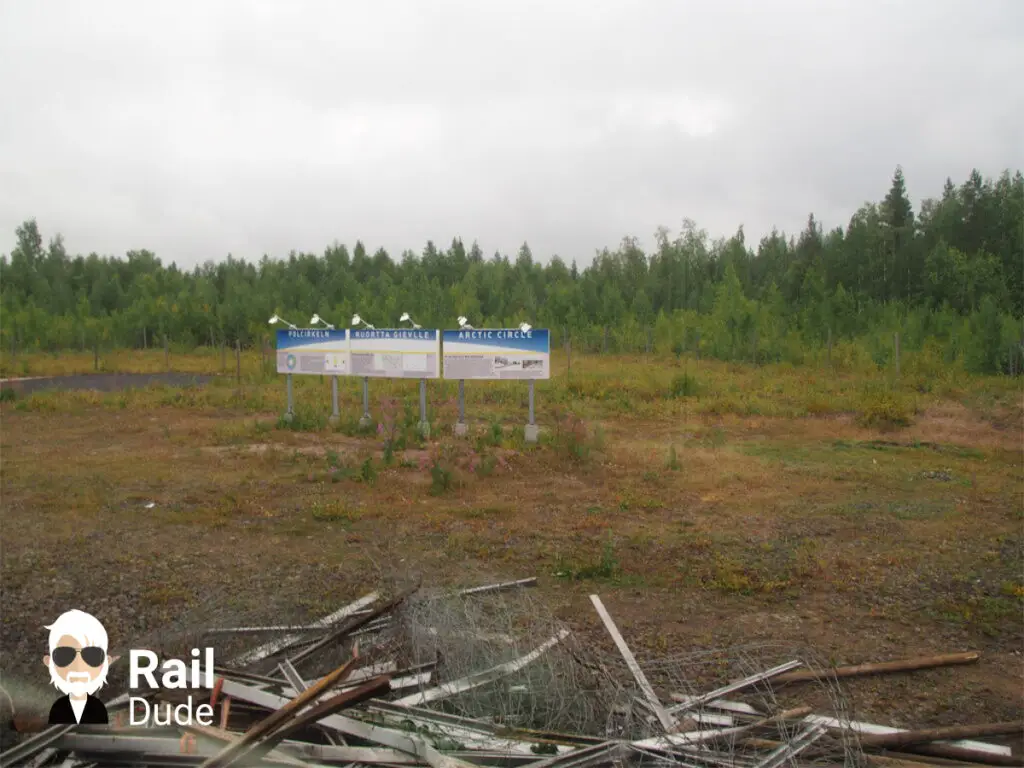
Sign at the Arctic Circle.
The journey to Kiruna is not really worth seeing. I take a quick look around the dining car. Next we reach Gällivare.
The stations
1) Kiruna
The biggest attraction in Kiruna is the mine. Iron ore is mined in Kirunavaara (Ptarmigan Mountain). It is precisely this ore that gives the Lulea-Kiruna-Narvik line its name: Ore railway. It was built solely to transport the ore from Kiruna to the harbours in Lulea and Narvik.

Kiruna ore mine in the background.
It was precisely because of this ore that Sweden was occupied by the German Reich during the Second World War and forced to hand over the iron ore, as it was important for weapons production. There was also a major battle for Narvik, more on that in a moment.
Please note: the mine costs a whopping 26 euros entrance fee, which I found really expensive. From mid-August there are only two guided tours a day (in the morning and at 2 pm), in July there are three or four.
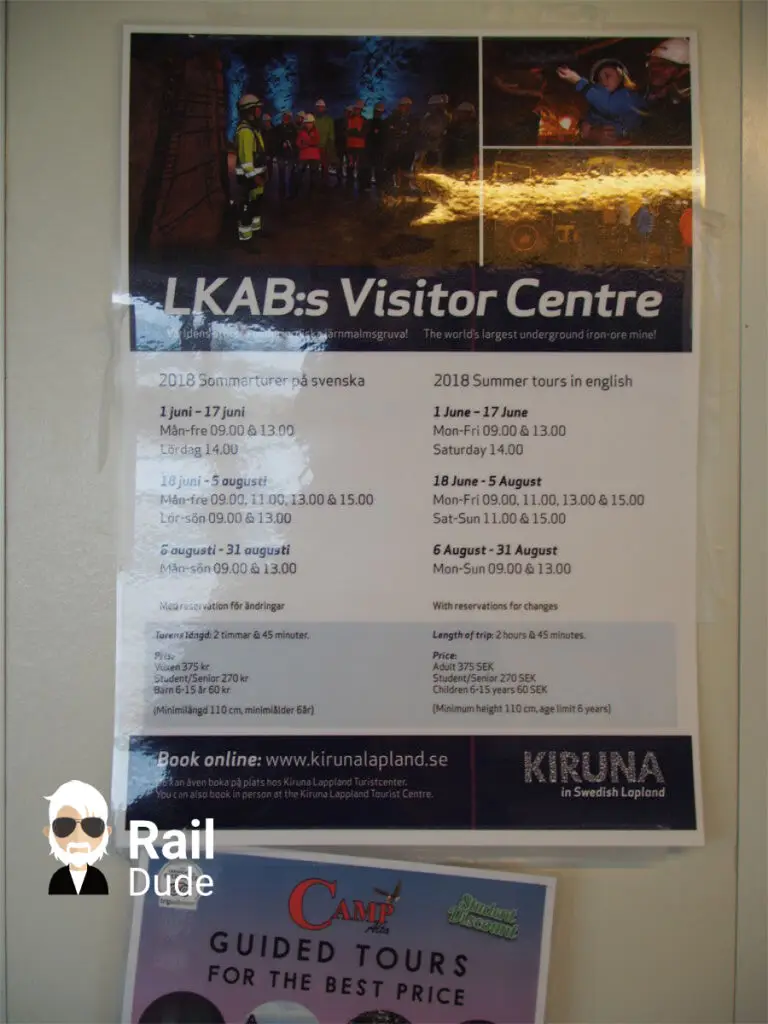
Kiruna mine management plan: the times should remain the same because the 2018 plan was still on display in 2019.
Travelling by train from Narvik (arrival 13:47) is somewhat problematic. The train station is a 23-minute walk from the starting point of the tour in the centre and they expect you to be there 15 minutes before it starts. My train arrived (late at the time) at 13:47 (actually 13:31) and I had to unpack my one 1000 metre run (with rucksack!) to make it, as they weren't prepared to wait even a minute despite calling. I was also told that other travellers who had arrived on the same train were already there. A bit cheeky, because without a taxi? Impossible!
From Kiruna you can either drive back south to Inlandsbanan in Gällivare or to Finland (Kemi).
2) Abisko
There are two stations in Abisko: Absiko Ost (Östra) and Abisko Turiststation. Abisko East can be easily recognised by its characteristic railway station with tower, which many stations here have. The Kungsleden, a well-known hiking trail, starts at Abisko Turiststation. You can also start from here to climb Kebnekaise, the highest mountain in Sweden. There is a youth hostel right next to the railway station for all hikers.
3) Narvik
My favourite destination in the north. Even if you can't think of what's there off the top of your head, there was plenty to discover. The ore railway ends here at Narvik harbour, which is located further north than Lulea, but is ice-free all year round thanks to the Gulf Stream. This is why it is so important and why there was a major battle for the town during the Second World War. There is a museum in the centre about this, which I found very interesting. In the afternoon, we decided to climb a mountain. The mountain "Linken" is 1003 metres high and would offer an amazing view (weather permitting). Logically, you start in Narvik at an altitude of only about 50 metres. Nevertheless, we were at the top in around 3.5 hours and back down again in a good 2 hours. As you might have guessed, unfortunately there was fog and we saw absolutely nothing, including wet shoes. Nevertheless, the personal success was worth it! A hike along the fjords also has a lot to offer. I recommend staying in Narvik for two days, e.g. two nights when travelling there and back on the night train. But expect only about 10 degrees during the day, even in summer.
From here you can continue by bus to the Lofoten Islands and to the North Cape.
Stay overnight without a hostel
For me, a hostel was always the first choice for Interrail. Unfortunately, there are none in Kiruna and Narvik, apart from supposedly a youth hostel in Kiruna, which I couldn't find or book. However, there is some great accommodation on Airbnb. If you're travelling as a couple or three, it's really worth it. There are very few single rooms. I was still lucky enough to get one for around 25EUR each. Otherwise you can also at Booking.com check.
The journey on the ore railway
The journey is supposed to be very beautiful and worth seeing. Unfortunately, I wasn't lucky with the weather, so I certainly missed a lot, for example the Lapporten (Lapps Gate, the gateway to Lapland), which I really wanted to see. You can find great pictures in the Blog from Flo
So unfortunately my report can't hold a candle to this one. Nevertheless, you can briefly read and see my experiences here:
Let's start the journey on a rainy morning in Narvik, it's mid-August, and in the misty background of the railway station you can see the right-hand pillar of the "Suspension Bridge".
I take a few photos of the locomotive and the carriages to Lulea. The display board announces that the night train to Stockholm has been cancelled today and at the very bottom it shows the booster train from Kiruna, which I mentioned above.
The train consists of four carriages and has two special features: a kind of "club compartment", where ten seats are arranged in a circle. It is the only "compartment" here that also has a door. The rest of the train is made up of normal seats in rows with sometimes green and sometimes blue cloth.
And there is a dining car. You can only buy snacks there, but at a very good price. You can see a picture of the menu here:
For those who don't speak Swedish/Norwegian: Example: Yoghurt with muesli 25 kroner/ 2.50 EUR.
I also just translated it freehand, but I think Norwegian is very similar to German. "Ankomst", meaning "incoming trains", obviously also has some similarities. Nevertheless, as a normal German, you can never understand a Norwegian when they speak, in my experience.
The journey begins with a steep ascent. At Rombaksfjord the line winds its way up the mountain, even from more than 300 metres above sea level you can still see the fjord, but not today because of the clouds. The line is single track, but there are always meeting points where trains can be let through. Most of the oncoming trains are ore trains from the mine in Kiruna.
The last Norwegian stop is Björnfjell, after arriving on the "Björnfjell". This is the plateau that you reach after climbing up the fjord. Here we also see an ore train.
Then comes Riksgränsen. Anyone who is a bit creative with the language here and perhaps also knows that Sweden and Norway used to be one kingdom, but are now "two kingdoms", will know that this is the border of the kingdom. The train stops there and sometimes even policemen walk through the train.
Then there are a few lakes and in the background you can see scattered snow on the lower mountains, and in sunny weather large snow fields on the higher ones. The whole thing in the middle of summer, also known as a glacier. Soon we reach Törneträsk, a very long lake, along the banks of which we cycle for about 60 kilometres.
Abisko is also on its side. Some hikers get on at the "turiststation" and the train fills up. Note: There is a second station in Absiko. Abisko-Östra (east). Make sure you get off at the right place, otherwise you have to walk about 5 kilometres.
In Abisko-Ost you get a good impression of what every railway station will look like from now on: a large building with a tower. Unfortunately, I don't know what its function is. But it certainly caught my eye.
Let's take another look at the Törneträsk before we go to my favourite place on the train: Right at the back. This is certainly only useful on carriage trains, as you can watch everything go by from the back. I love that!
We then soon arrive in Kiruna. The town is currently experiencing an eventful history. It is being moved because of the mining industry. But why is that, you might ask? Mining is underground, so mostly... Right! However, when ore is mined here, blasting is carried out and this causes the mountain to slide. And the further you penetrate into the area under the city, the more the ground sinks there too. Up to 10cm. per week (!). But in these places, the houses have already been demolished. So was the old railway station. A single buffer stop could still be found in the "Järnvägsparkan" (railway park, now a green area).
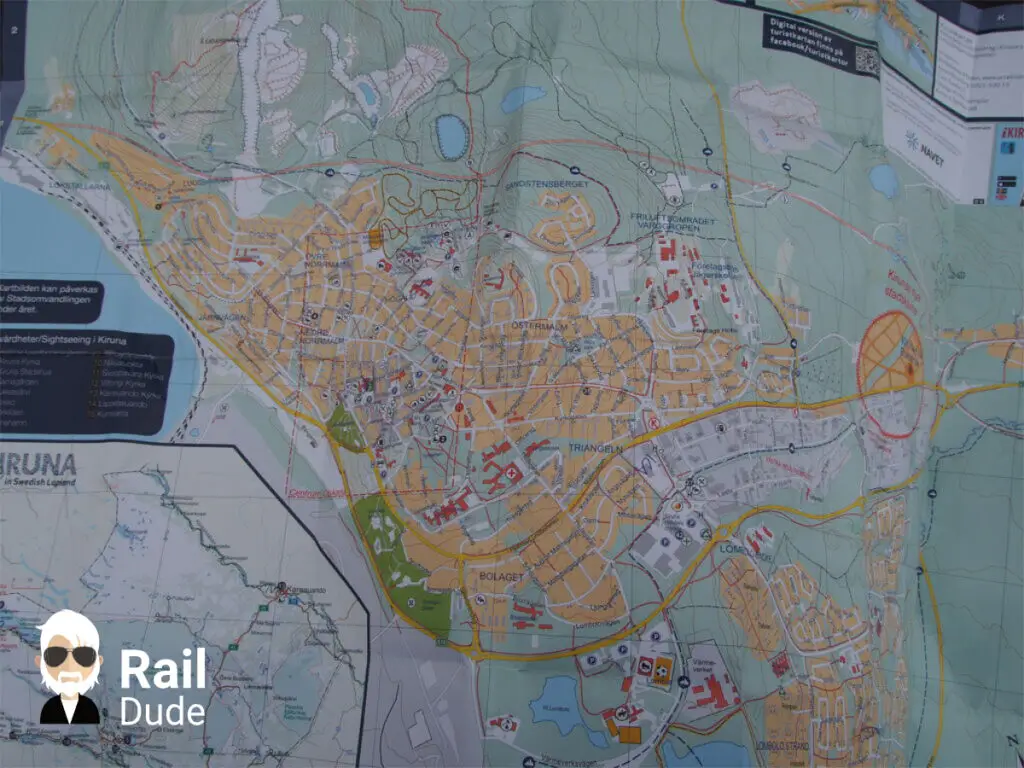
On the right (red circle) "Kiruns nya stadskärna" - the new planned city centre
In my opinion, the "new", actually "temporary" railway station has a few pitfalls. It has, believe it or not, exactly one track. And is a terminus station. And is outside the city. About 2.5 kilometres. Although there is a shuttle bus to the bus station (roughly in the centre), it doesn't have such great journey times. It usually only leaves about 10-15 minutes after the train arrives and for departing trains it also arrives about a quarter of an hour before departure, so it is usually at the same time if you walk. This was also the case for me.
My train couldn't enter the station because the only track was still blocked. We accumulated more than a quarter of an hour's delay just before the end (scheduled arrival at 1.31pm) and so my aforementioned sprint to the mine tour followed at 2pm. 2.5 kilometres in 11 minutes. With rucksack.
The next day I travelled on to Lulea by train and took the bus for the only time out of three. This ends and departs at the bus station. The mine tour starts at the info point, here is a picture of the city map.
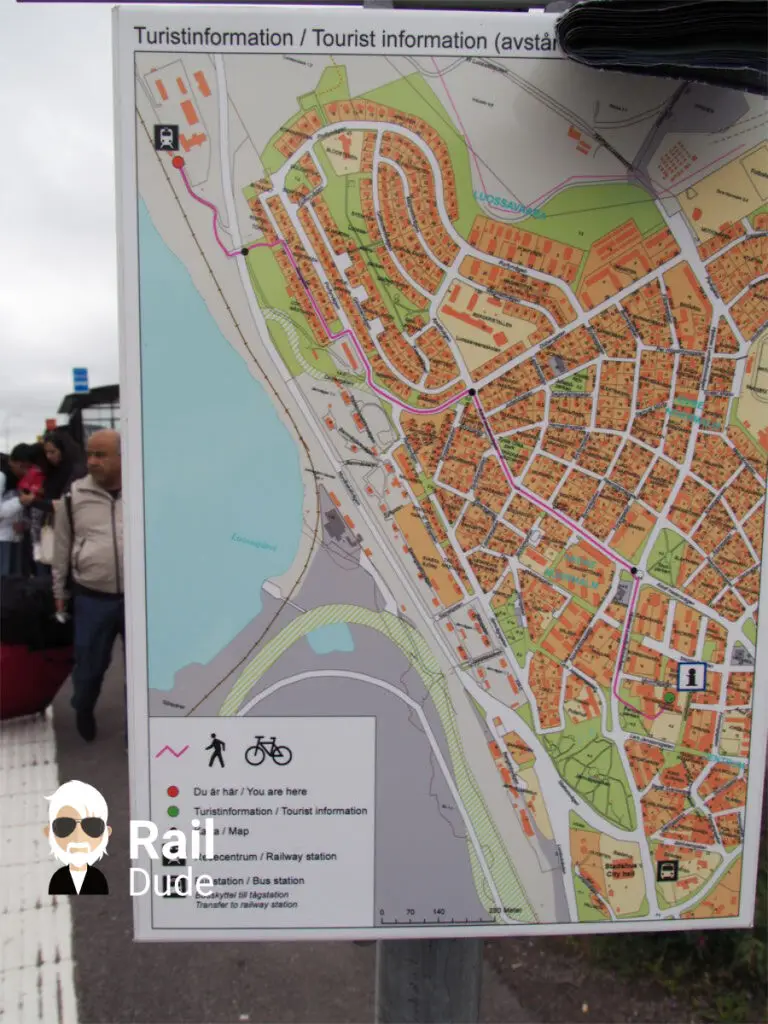
The "i" for information is at the bottom right of the image, with the bus symbol below it.
On this day I also had time to take a few pictures of Kiruna station. As I said: only one track, a small waiting hall.
The monument at the railway station. There is also a city map on the left.
Finally, once again our booking links to the Tickets/Reservations and Interrail passes.
If you want to stay overnight in Kiruna and Narvik, then take a look at here.
My journey continued from Kiruna to Finland the next day. More about this in my next blog. In Kiruna itself there wasn't really much to see apart from the mine in my opinion, maybe the church (opening hours approx. 09:00 to 15:00).
Finally, here is a film by Peter and Flo about the night train from Stockholm to Narvik. With many sequences on the Kiruna to Narvik section.
Important links
Timetable / journey time approx. 3:00 hours: SJ - Swedish railway
Buy train tickets. Price depends on date of travel and train class, from 15 EUR: SJ - Swedish railway
Book a hotel in Narvik and Kiruna: Booking.com
InterRail - a train ticket for the whole of Europe: InterRail
